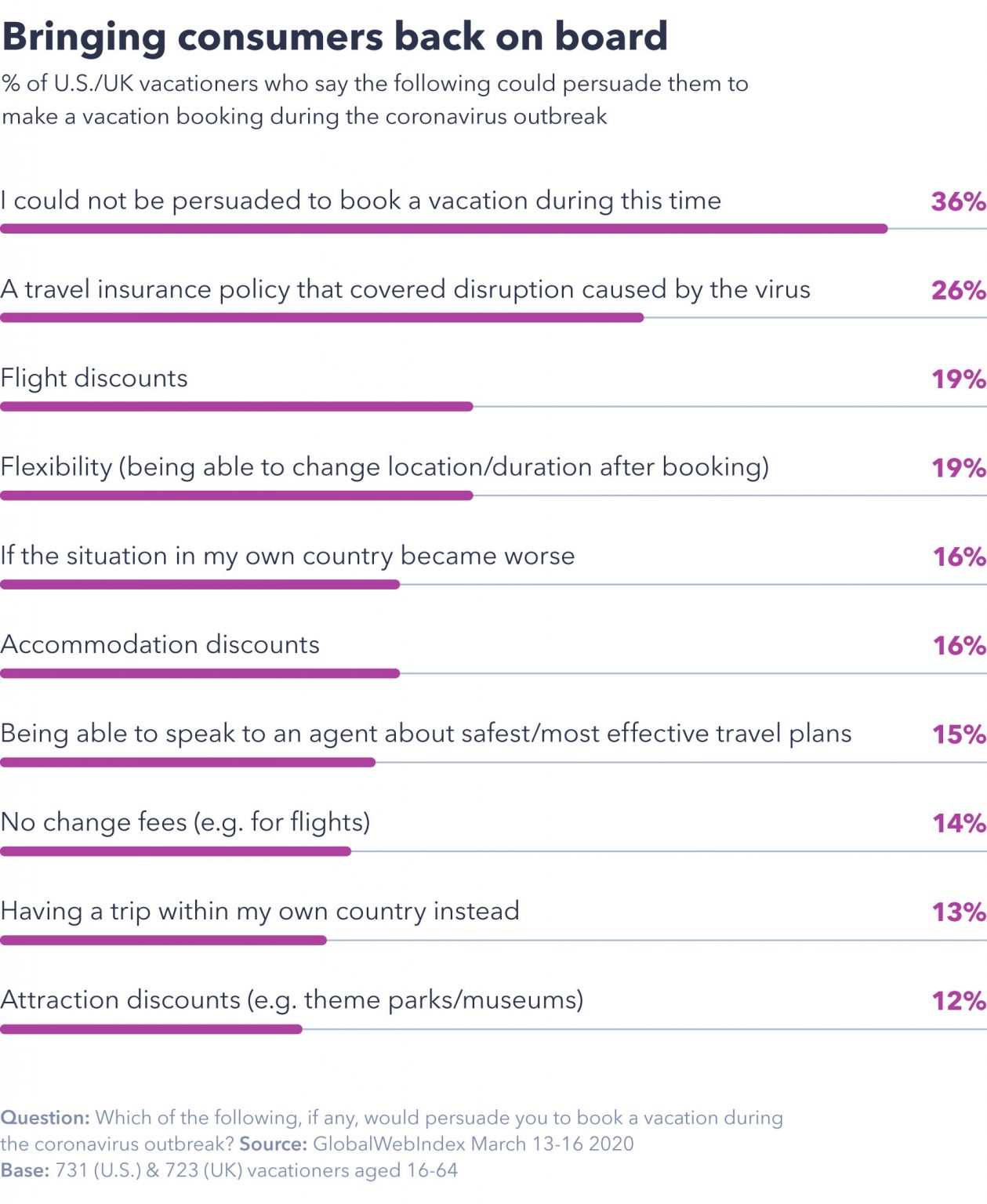What Will Travel Look Like After COVID-19?
What Will Travel Look Like After Coronavirus?
Traveling is a luxury that everyone wants to experience. A great way to relax, indulge in ethnic cultures, and a fabulous excuse to eat as many things and shop as much as possible. However, the travel industry took the biggest hit during the COVID-19 epidemic. From the beginning of the epidemic, consumers were hesitant to travel to back to their countries. Some immediately purchased tickets to return home as soon as possible. Others took advantage of the cheap airline tickets to take a short vacation. As COVID-19 began to spread rapidly, travel restrictions were in place and demand for flights and cruises decreased. Airline stocks dropped sharply as investors reckoned with the prospect of canceled flights, lost sales and substantial reductions in service for months to come. Travel for some is a luxury, but for many a necessity. On social media, travelers shared images of planes devoid of passengers. Others posted photos of empty airports and tarmac workers wearing full-body protective gear. Airports support ecosystems of restaurants, stores, taxis and hotels that will all be affected if air travel remains depressed. As the virus slowly fades, businesses are looking to reopen and engage with their consumers again; but how will the travel industry look like after Coronavirus?

Before the virus, The World Tourism Organization predicted a positive growth of 3% to 4% for this year. Once the virus occurred, the statistic changed that “its 2020 prospects for international tourist arrivals to a negative growth of 1% to 3%, translating into an estimated loss of US$ 30 to 50 billion in international tourism receipts” (“COVID-19: UNWTO Calls On Tourism To Be Part Of Recovery Plans“). To prepare for recovery, they have called for financial and political support for recovery measures aimed at tourism, and to include support for the sector in the wider recovery plans and actions of affected economies. Political and financial commitments are key to ensure that tourism can lead wider economic and social recovery. As the UN agency responsible for tourism and sustainable development, the UNWTO “stands ready to provide guidance and support for recovery measures of its members, the private and public tourism sector, including organizers of tourism events and fairs” (“COVID-19: UNWTO Calls On Tourism To Be Part Of Recovery Plans“).
However, people are still talking about traveling after this period! People will either travel within their own country, won’t travel far from home, or plan quick vacations like a weekend long rather than the standard two week. Staycations in well-known luxury and boutique hotels within big cities could surge as people refrain from traveling afar. Those benefiting will be the most trusted brands of hospitality as people will look at hygiene standards first. Surveys have been conducted and it has been concluded that more than “half of Americans (58%) are planning to travel between May and September 2020, as long as their destinations aren’t in quarantine. But they’re being careful. A quarter of participants will try to avoid big cities and public transportation, and 21% will choose domestic travel” (“What Will Travel Be Like After The Coronavirus?”). Consumers will look at the overall value of the deal, not just the pricing. Focus on well-known brands that are financially stable, not the too-good-to-be-true offers from unknown operators. Consider a travel insurance, allowing protection in case the operator goes out of business. Can’t find a good policy? No problem, use a credit card to make your purchase. It can also offer protections from financial insolvency (“What Will Travel Be Like After The Coronavirus?”).









Predictions have been made left and right on what could occur in the travel industry, both positive and negative. Free individual travelers will want to travel as soon as it feels safe again. But meetings, incentives and conferences take a long time to plan, and there is a significant reputational risk involved for the companies that organize them. Consumers in their late thirties, forties and early fifties, will be leading the rediscovery of traveling. Villas and small boutique hotels will go in high demand, but overcrowded destinations will take a longer time to recover (“Post-Coronavirus Travel and Tourism: Some Predictions”). Another survey conducted by Fodor’s Reader claims that “52% said they would start after six months, while heading overseas is on the table for 13% and 33% of them, respectfully” (“What Will Travel Look Life After the Pandemic?”). Domestic travel will likely be easier to accomplish, especially if borders remain tight and travel bans are still in place. But international travel may not be seen until there is a vaccine available for everyone, to ensure that the risk of contracting Corona is slim. The most affected destinations will be remote locations as air travel will make it difficult or very costly to reach. Based off of previous tragic events, such as 9/11, “airlines responded with deeply-discounted airfares, and budget airlines popped up everywhere, including low-cost spinoffs of major airlines like Delta Song” (“What Will Travel Look Life After the Pandemic?”). Tour operators, cruises, and flights are already offering special discount, such as going for much less than the usual market rates, free changes, and cancellations.
However, cruises may not recover so lightly like airfare. People have already witnessed how quickly pathogens can spread at-sea, especially those who have experienced the quarantine aboard a ship. Many cruises are appealing to the older, more vulnerable age group who are prone to contracting diseases. However, many known cruise brands – Royal Caribbean, Carnival, Holland America – are considering adding couple more ship doctors, more medical equipment, and different kitchen facilities and staff. Thus, giving reassurance to consumers that their brand is more equipped and will not make the same mistakes again. Similar to how ships included more life vests and life boats after the sinking of Titanic. Airports may take similar precautions such as requiring temperature screenings for passengers before they board a flight (“What Will Travel Look Life After the Pandemic?”).

With summer fast approaching, people would usually plan their spontaneous family trips, go on a trip with college friends, or even embark on a solo journey. Many families, groups of friends and solo traveler are wondering just how long coronavirus will remain and continue to impact traveling. May and June have been estimated to be the months of when the virus will slowly begin to decrease, specifically in countries that have been affected first. It’s important to take the following precautions to ensure that you and your family members are able to travel once it is safe. Follow the COVID-19 updates in your home country, as well as the country you plan to travel to. Always check the latest Coronavirus travel advice, the WHO and the authorities of your home and destination country are offering practical guidance for people travelling and living overseas following the outbreak of COVID-19. Continue to practice social distancing while traveling. Make sure to wash your hands with soap often, avoid touching your eyes, nose and mouth, and use alcohol wipes and gels with at least 60 percent alcohol. If you’re feeling anxious about traveling, then it’s better to stay home and take precaution rather than risk traveling and jeopardizing your health and the health of others (“Safe Travelling After Coronavirus Ends: How, When and Where?”).

Business travel has seen a blanket of cancellations in the last couple of months. More companies have cancelled or suspended business travel until they foresee a change in the rising number of cases of the coronavirus. Global companies with a presence in numerous countries have triggered concern as to how to plan out activities for the rest of the year. Scott Solombrino, COO of the Global Business Travel Association states, “Coronavirus is significantly impacting the business travel industry’s bottom line. As the virus continues to spread, across the world, business travel is slowing at an alarming rate. The impact of the business travel industry – and to the broader economy – cannot be underestimated.” Companies will need to reevaluate their traveling policies post-coronavirus based on the criteria of importance, value and safety. Alternative methods will need to be set in place, in order to limit on-the-go travel. Opting for online conference calls than face-to-face meetings or virtual site visits could be ways businesses revise their corporate practices.

What can brands do to ensure safety to consumers, as well as loyalty towards their customers? It’s important to stay engaged with customers and make sure they are aware that they are a priority. While many travel companies are cutting back budgets, it is important to continue emphasizing marketing. Travel companies are integral parts of their local communities and should continue to find ways to actively participate in the COVID-19 response. For example, Delta is flying medical volunteers for free and the Four Seasons in New York is accommodating free rooms for healthcare workers. Travel brands can also learn from companies based off of previous recession periods. Researchers have found that brands increase their recovery post-recession by building brand value and awareness during the recession. By digitizing and streamlining your contact center, companies “can reduce call center volumes by streamlining digital touchpoints to make it easier for customers to cancel and rebook via digital channels. Leading companies have blended their digital and call center teams, automating the use of natural language processing tools to analyze calls and optimize customer demands fluidly across channels” (“Preparing for a Post COVID-19 World: 4 Ways Travel Brands Can Learn from Past Events”). Companies should be prepared to reevaluate their competitive landscape. It is essential to analyze customer behavior, identify the right prospects, and look for signals to identify when travel is picking back up. Once identified, companies can streamline their marketing technologies and be able to send the accurate message to their target audience. It is also vital for brands to bring attention to health and wellness through contactless technology and other safety procedures. This will give consumers a peace of mind when it comes using biometrics, gesture controls, and automation, to personalize digital interactions while enabling social distancing (“Preparing for a Post COVID-19 World: 4 Ways Travel Brands Can Learn from Past Events”).
It’s important to take precaution during a time like this. While it is important to bring businesses back to their fullest potential, it is also important to continue practicing social distance. But, once the virus is slowly disappearing and it is safe to travel again, then get back out there! Continue being cautious by constantly washing your hands and keeping a convenient bottle of hand sanitizer on you. Always make sure you have a backup in case the flight gets cancelled with a flexible cancellation policy. But for now, sit back and relax at home. Because your health and safety is more important.





